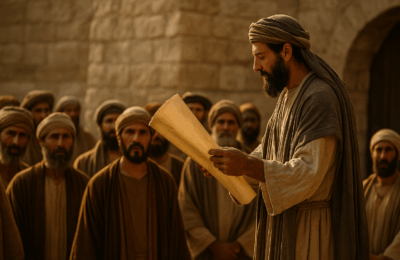Home | Bible Resources | Historical Books
Esther: Providence in the Shadows: God’s Hidden Hand and the Preservation of His People
Introduction
Esther is the only book in the Bible that never mentions God by name — yet His fingerprints are everywhere. Behind royal feasts and courtly intrigue, Esther unfolds a dramatic rescue of God’s covenant people from genocide in Persia. It’s a book of great reversals: an orphan becomes queen, a villain is hanged on his own gallows, and mourning is turned into joy. Esther invites us to trust God’s providence even when He appears silent — for He is always at work to preserve His promises and protect His people. It reminds us that divine sovereignty and human responsibility are not in conflict but in concert, orchestrating redemption in the shadows.
1. Title, Author, and Date
The book of Esther records the deliverance of the Jewish people in Persia through the courage of a faithful queen and the unseen providence of God.
Title Meaning: “Esther” (אֶסְתֵּר) likely derives from the Persian stara (“star”), echoing the Hebrew root satarmeaning “to hide.”
Authorship: Unknown; traditionally associated with Mordecai or a Persian-era Jewish scribe. The detailed court knowledge supports an eyewitness or informed source.
Date: Likely written between 460–350 BC. The events occur between 483–473 BC during the reign of Xerxes I (Ahasuerus).
Historical Setting: Post-exilic Jews still living in Persia during the diaspora. The events occur after the temple was rebuilt (Ezra) but before Nehemiah’s return.
Role in Redemptive History: Preserves the Messianic line by thwarting a satanically influenced plan to annihilate the Jews — safeguarding the Abrahamic and Davidic covenants.
Covenantal Lens: Although the Mosaic covenant is not mentioned, God’s faithfulness to the Abrahamic promise of preservation (Gen 12:3) is on full display.
Book Stats:
Chapters: 10 (+ postscript)
Verses: 167
Approx. Word Count (LSB): 5,600
2. Purpose and Themes
Esther’s purpose is to reveal God’s providential care over His covenant people, even in exile, and to explain the origin of the Jewish festival of Purim.
Theological Purpose: To show that God’s sovereign hand is always at work, even when His name is not spoken, preserving His people and unfolding His redemptive plan.
Major Doctrines:
- Divine providence and preservation
- Human responsibility and moral courage
- Reversal of fortunes (divine justice)
- National identity and deliverance
Structural and Literary Features:
- Irony, suspense, and repetition (e.g., feasts, edicts)
- Chiastic structure (e.g., rise and fall of Haman vs. Mordecai)
- Use of narrative tension and dramatic reversal
3. Outline
The story follows a classic reversal arc: danger builds, deliverance arrives through unexpected means, and God’s people are saved from destruction.
I. The Fall of Queen Vashti and Rise of Esther (1:1–2:23)
A. King Xerxes hosts lavish feasts (1:1–9)
B. Queen Vashti removed for refusing his command (1:10–22)
C. Esther chosen as queen after national search (2:1–18)
D. Mordecai uncovers a plot and saves the king (2:19–23)
II. Haman’s Plot to Destroy the Jews (3:1–4:17)
A. Haman’s rise to power and hatred for Mordecai (3:1–6)
B. Haman’s decree of annihilation (3:7–15)
C. Mordecai and Esther’s dialogue and fasting (4:1–17)
III. Esther’s Courage and God’s Reversal (5:1–7:10)
A. Esther risks her life to approach the king (5:1–8)
B. Haman’s pride and plans for Mordecai (5:9–14)
C. The king honors Mordecai instead (6:1–14)
D. Esther exposes Haman; he is executed (7:1–10)
IV. Deliverance and the Feast of Purim (8:1–10:3)
A. A counter-decree permits Jewish self-defense (8:1–17)
B. Victory over their enemies (9:1–19)
C. Institution of Purim to remember God’s deliverance (9:20–32)
D. Mordecai’s promotion and legacy (10:1–3)
Canonical Flow: Esther concludes the historical narrative before the intertestamental period, preserving the Messianic line through unseen providence.
4. Key Themes and Theological Contributions
Esther speaks through silence — where God’s name is absent, His presence is unmistakable. The book develops a theology of hidden providence, moral courage, and national preservation.
Redemption and Preservation: God acts sovereignly to preserve His people against satanic opposition — part of the broader Redemption arc leading to Christ.
Providence and Responsibility: Though God is unseen, His orchestration is evident. Esther and Mordecai model faithfulness and courage amid uncertainty.
Covenant Continuity: Esther is evidence that God is keeping His covenant with Abraham — blessing those who bless Israel and cursing those who curse her (Gen 12:3).
Typological Reversals: Gallows prepared for Mordecai hang Haman instead — a picture of divine justice and eschatological reversal (cf. Rev 20:10).
📌 Memory Verse: Esther 4:14b (LSB) — “And who knows whether you have not attained royalty for such a time as this?”
⚔️ Major Rebellions/Turning Points:
- Haman’s Decree of Annihilation: A genocidal threat looms over all Jews, echoing the cosmic war against the seed of the woman (Gen 3:15).
- Esther’s Decision to Intervene: Facing potential death, Esther chooses courage over comfort — aligning herself with God’s purposes (Esth 4:16).
- Divine Reversal through Purim: Mourning turns to joy, and destruction becomes deliverance — demonstrating God’s power to reverse the schemes of the enemy (Esth 9:1).
5. Christ in Esther
Though Esther never mentions God, the book foreshadows Christ’s redemptive mission — hidden yet unstoppable, reversing judgment through divine timing.
Typological Glimpses:
- Esther as a mediator who risks her life to save her people (Esth 4:16) → foreshadows Christ, who intercedes to deliver His people (Heb 7:25)
- Mordecai’s exaltation mirrors Christ’s vindication after suffering (Phil 2:9–11)
- Haman’s fate prefigures the final defeat of Satan and all who oppose God’s people (Rev 20:10)
Christological Themes:
- Christ as the better intercessor (Esth 5:1–2 → Heb 4:16)
- Purim as a foretaste of the joy of redemption (Esth 9:22 → Luke 15:32)
Cross-Reference Chart
| Esther Figure/Event | Fulfillment in Christ |
|---|---|
| Esther intercedes for her people | Jesus intercedes before the Father (Heb 7:25) |
| Mordecai’s exaltation | Christ’s resurrection and enthronement (Phil 2:9) |
| Purim celebration of deliverance | Salvation joy in Christ (John 16:20–22) |
| Haman’s downfall | Satan’s final judgment (Rev 20:10) |
6. Historical and Literary Notes
Esther is rich in historical authenticity, literary irony, and theological implication. It invites reflection on divine sovereignty in secular spaces.
ANE Parallels:
- Persian court customs (banquets, decrees, royal protocol) align with Herodotus’ historical accounts of Xerxes’ reign.
- Purim derives from the pur (lot) Haman cast — transformed by God’s hand into a celebration of life.
Genre Observations:
- Historical narrative with dramatic irony, legal formality, and royal documentation
- Rich in suspense and reversal — central to its theological message
Theological Contribution:
- Providence without miracle
- Courage without command
- Victory without visibility — all part of God’s sovereign design
👤 Key Characters:
- Esther – Orphaned Jewish girl turned queen; bold intercessor and wise strategist
- Mordecai – Esther’s cousin and guardian; righteous civil servant exalted by God
- Haman – Prideful enemy of the Jews; plots genocide and faces divine reversal
- Xerxes (Ahasuerus) – Persian king; impulsive yet instrumental in God’s purposes
- The Jews in Persia – The covenant people, scattered yet preserved
7. Applications for Today
Esther shows believers how to live faithfully and courageously in a world where God’s name may be silenced — but His rule is never absent.
Discipleship Formation
- Faithfulness in obscurity is often the stage for God’s greatest work
- Courage may cost everything — but obedience is worth it
Worldview and Ethics
- God is present even when culture seems godless
- Believers must stand for truth and protect the vulnerable in hostile environments
Leadership and Mission
- Esther models principled courage and timely wisdom
- Mordecai shows that influence often grows through quiet faithfulness and unwavering loyalty
8. Shoe Leather Discipleship Tie-In
This book shows us that even when God seems absent, He is always active — guiding, preserving, and delivering His people for such a time as this.
Esther challenges us to trust the providence of God in seasons of silence. It reminds us that God’s sovereignty doesn’t always shout — sometimes it whispers through circumstances, reversals, and moral courage. In a post-Christian world, the book of Esther equips believers to live as exiles with conviction, compassion, and confidence. Walking with God means risking safety for obedience, trusting divine timing, and believing that no moment is wasted when placed in the hands of the invisible King.







